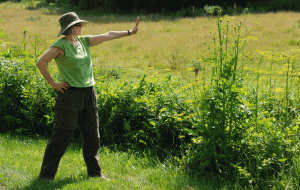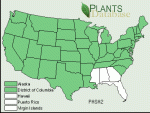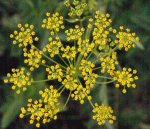I first walked my land on Labor Day Weekend 2004. I was responding with a pounding heart to the topographical nuance of a protected hollow where a ravine and another, wider valley meet under a big bowl of sky. I was already bonding to the rows of toddler pine, spruce and oak that I had instantly taken under my wing. The seller had just mowed between them so they would look promising, rather than lost in the grass. I barely noticed the tall dried stalks filling the gaps between each tree or the thick stubble between the rows.

Not suited up, so keeping my distance
If I had known that much of that stubble was the harmless remains of Wild Parsnip, would it have made any difference? Probably not. I was in love with that land. The honeymoon lasted till the next summer when just about every square foot of the 44 acres that wasn’t heavily shaded under mature trees – more than half – had burst forth in a fresh and flourishing crop of Wild Parsnip. It was as if someone you thought was sweet and gentle suddenly snarls and bears their teeth at you.
You’ve seen Wild Parsnip from your car window. It grows in drifts along the roadside just about everywhere.  Its numbers have exploded in Wisconsin, probably because the seeds are spread by roadside mowing in late July and August when it goes to seed. Wild Parsnip is a member of the carrot family. It’s easy to recognize because it resembles its cousin, Queen Ann’s Lace, but its big, flat flower is greenish yellow instead of white.
Its numbers have exploded in Wisconsin, probably because the seeds are spread by roadside mowing in late July and August when it goes to seed. Wild Parsnip is a member of the carrot family. It’s easy to recognize because it resembles its cousin, Queen Ann’s Lace, but its big, flat flower is greenish yellow instead of white.

Isn't that pretty?
DON”T try to gather a bouquet! This stuff is armed and dangerous. There’s something in its sap called psoralen, which is a photo carcinogen. That means it has a destructive effect on DNA when exposed to sunlight. Psoralen was actually used as a tanning activator in sunscreens until 1996. (Some people suffered severe skin loss after sunbathing with psoralen-containing tanning activators according to an article in Nature. People with lighter skin color are more prone to this damage.
According to Jerry Doll, in WeedScience, University of Wisconsin, when psoralen gets on, and then into your skin, it is activated by uv light (on both sunny and cloudy days). In this excited state, it binds to DNA and cell membranes, destroying cells and skin.
Psoralen takes a day or two to do its damage. A mild case turns skin red and feels like sunburn, or in the worst case, you will feel like you have been scalded, develop blisters and will be left wearing dark red patches on your skin that won’t totally fade away for a year or more. (I live in constant fear during Parsnip Season that I am going to get some on my face without realizing it.)
Staying out of the countryside won’t necessarily protect you. For a horror story about an urban gardener’s run in with the stuff, click here. I need to add that just brushing against the plant won’t burn you. You have to crush or cut it and get the sap on you. Click here to learn about treatment.

This stuff is not kidding around!
So, of all the invasives – and the list is long – that I am working to minimize, Wild Parsnip heads the list. We have a Zero Tolerance Zone that originally covered the whole place, but reality has whittled it down a bit. During the last days of June and the first days of July, removing Wild Parsnip is our prime directive. With arms and legs covered and wet wipes at the ready, we have been following the guidelines to eradicate it. You need to cut it after it flowers but before it goes to seed. Because of its carrot affiliations, it has a lot of energy stored in a big tap root, so it can send up another stalk and flower again. Beating it takes repeat cuttings and true diligence. This year at last, we are stating to see a lot less of the stuff in all the areas we have declared Zero Tolerance.
At first, we mowed it out between the rows of trees with our walk-behind DR Brush Mower (This thing really works. We got ours here. ) and followed up with scythe work, one plant at a time. (American-made scythes don’t work. We found good ones here. )
Now, facing fewer foe all we need to do is scythe, and that we do with gusto. A good scythe is a beautiful instrument. You can hook the tip of the blade around a parsnip stalk growing next to a cone flower. Goodbye, parsnip. Carry on, cone flower! Since we started our acre-and-a half of prairie restoration we have walked it with scythes in hand multiple times each summer, cutting out every Wild Parsnip we see.
Last week, we walked out into the prairie to find very little parsnip to snip. What a joy! After the five years and countless hours that we have spent in this campaign, covered in full-protective clothing on sweltering hot summer days, – we seem to be gaining ground. That is energizing. I feel almost as excited as a photoactivated carcinogen exposed to sunlight.
To follow my other adventures in Invasiveland, check out
Pass the Garlic Mustard, Please
Purple Loosestrife, a very short battle
Milfoil Mulch, turning crap into crop
My next post on Tuesday will be about a practical resource — The Midwest Renewable energy Association.
HAVE YOU BATTLED THIS BEAST? CLICK “COMMENT” (LEFT, BELOW) AND SOUND OFF!
Categories: Ecosystem Restoration, TALES FROM OUR 44 ACRES
I know this might sound odd, but I know the one foolproof way to get rid of wild parsnip: Cows.
Yeah, I know. But they eat the stuff and it has no effect on them! I swear!
That’s good to know. I don’t have any livestock at this point, but have been thinking of goats. I have also seen some evidence that deer occaissionally eat the top of wild parsnip. Unfortunately, they eat the top of many things I wish they’d pass on, such as the blazing star I started this year from the seed I gathered last fall.
Denise
This is the second year in a row I have been burned after weeding my beautiful suburan flower garden adjacent to my home.
I wish I knew how to send you the pictures of the huge, painful, fluid filled blisters I have on both of my arms, from wrist to underarm.
The wild parsnip is now invading my ceder hedge.
It really hurts….
I have so much sympathy for you. I know how much it hurts, and it scars. I always feel that (truth in advertising) I have to warn guests before they walk the trails, that, though the chances are slight, they may get a parsnip burn, and I really hate the way it impairs their ability to have a good time out in nature. I (she tempts fate) haven’t gotten a burn in a few years, but I remember it well. My big fear is that I will get some sap on my face without realizing it and then watch an unsightly blister form when it’s too late to do anything about it.
I think I have had success when I realized I had sap on my by removing it promptly with several of the wet-wipes I carry with me at all times during parsnip season.
Best wishes on your speedy recovery
What an insightful post Denise. So glad you stopped by Flandrum Hill to share your painfully acquired knowledge.
I have had a minor infestation of the wild parsnips in a woodland behind my house. I can, luckily, capture the seed heads and carry them out. A friend with a much larger area wonders if he needs to gather the seed heads and carry them out when he cuts them down.
Sorry to take so long to reply. Ideally, you do need to keep those seeds from maturing and hitting the ground. If you can’t cut them while they are flowering, it’s still possible to slow them down by cutting and bagging the seed heads. I would warn you that I got one of my worst parsnip burns on my wrist while performing this procedure. So be careful. Don’t let those stems touch you!
happy hunting
I’m wondering, once you cut the parsnip down and/or dig out the roots — what do you do with the plant? How long is the carcinogen in the sap active after the plant dries up?
I have always just left it lie, and assumed that when it is dried out, it is not dangerous. After all, it is the sap that can do damage. If you brush against a leaf, nothing happens. You have to get the goo inside on you, and when the sap is dry, I don’t avoid it, and have had no problems. That’s my anecdotal info.
For those with sensitive skin, brushing lightly against the plant absolutely will cause burns. Trust me. Ouch.
You can also get burned without even touching the plant. The pollen in the flowers gives the worst burn. You put a sweaty person outside and the pollen just collects on them.
Another way to get burned by parsnip is swimming in a river with flowering parsnip on the banks. You’re basically swimming in a pollen pool!
Wow! I had no idea it was so vicious. I’m going to pay a lot more attention to the pollen from now on. Thanks for the heads up.
Oh, and be careful with hoses! I recently got burns all over my hands and stomach (I was wearing a swimsuit) by handling a hose that had been dragged through the parsnip!
Wow, that makes sense. A hose could easily bruise a stem enough to release sap.
Thanks for the warning. You have probably saved more than one gardener’s hands from parsnip burn.
I just figured out why I kept getting this itchy rash every time I weed wacked the neighbor’s yard. Now I’ll always wear pants over there.
Bummer about your itchy rash, but my experience is wild parsnip is not particularly itchy. It does bubble up like a burn and then leave a big purple scar. You may be dealing with another hostile member of the plant community.
My husband always wears long trousers (sorry being English I can’t bring myself to call them pants :)) when he uses the weed whacker because he gets covered in little red marks that itches and he has never worked out what causes it. I guess the sap of a common plant must be an irritant.
We have many acres of parsnip on our property. Cows here won’t eat it, so don’t try that….. We just bought a DR Power tow-behind trail mower to cut it all down. That thing is beautiful! Something else that I’ve seen work is lillies – they just grow so dense that they drown everything else out – but they take soooo long to multiply to a useful density…… You could also possibly use heavily seeded buckwheat and/or clover to drown it out, but who needs that much buckwheat year after year? (We’re trying to get parsnip under control before the Giant Hogweed onslaught hits our area – looks like parsnip, but bigger and much, much meaner. Parsnip is like a daisy compared to hogweed.)
Thanks for your comment, Kent.
We have just finished our battle for this year using scythes where the wild parsnip is thin and mechanical mowing where it is thick. We are seeing it diminish (although never really disappear) where we are really vigilant, but we are only trying to control a few acres.
We have used buckwheat as a ground cover, but I understand that it can become a nuisance if let go to seed, so I use it carefully.
And I agree about the day lillies. We transplanted some from Doug’s parents yard years ago at the entrance to our lane, but they are still only a very minimal presence there. The ones I see blanketing the roadside with blossoms must have been there since pioneer times!
I’m glad I don’t have to fight hogweed yet.
Good luck to you!